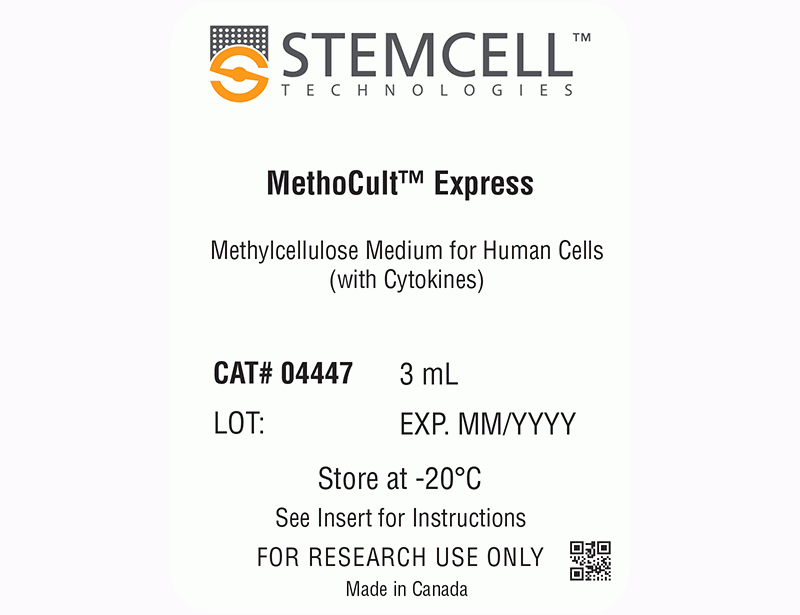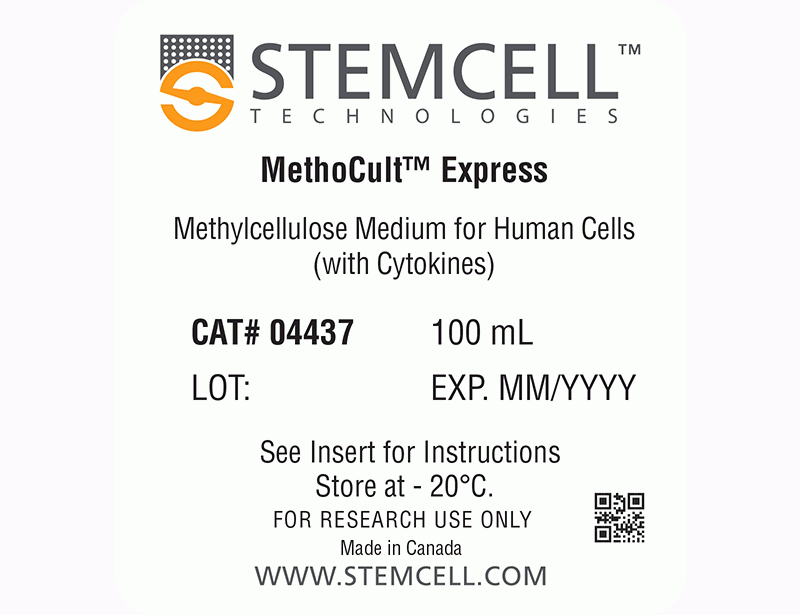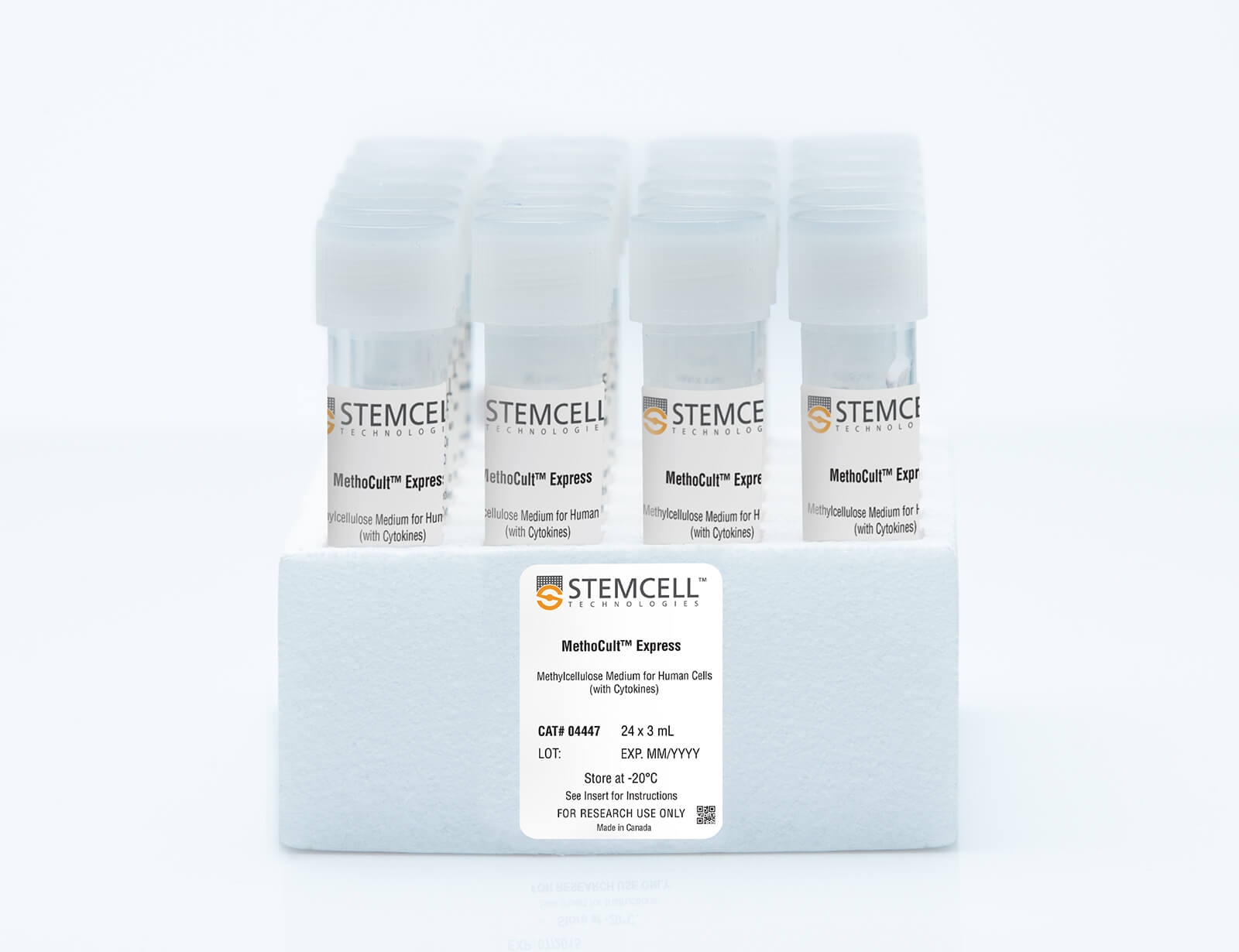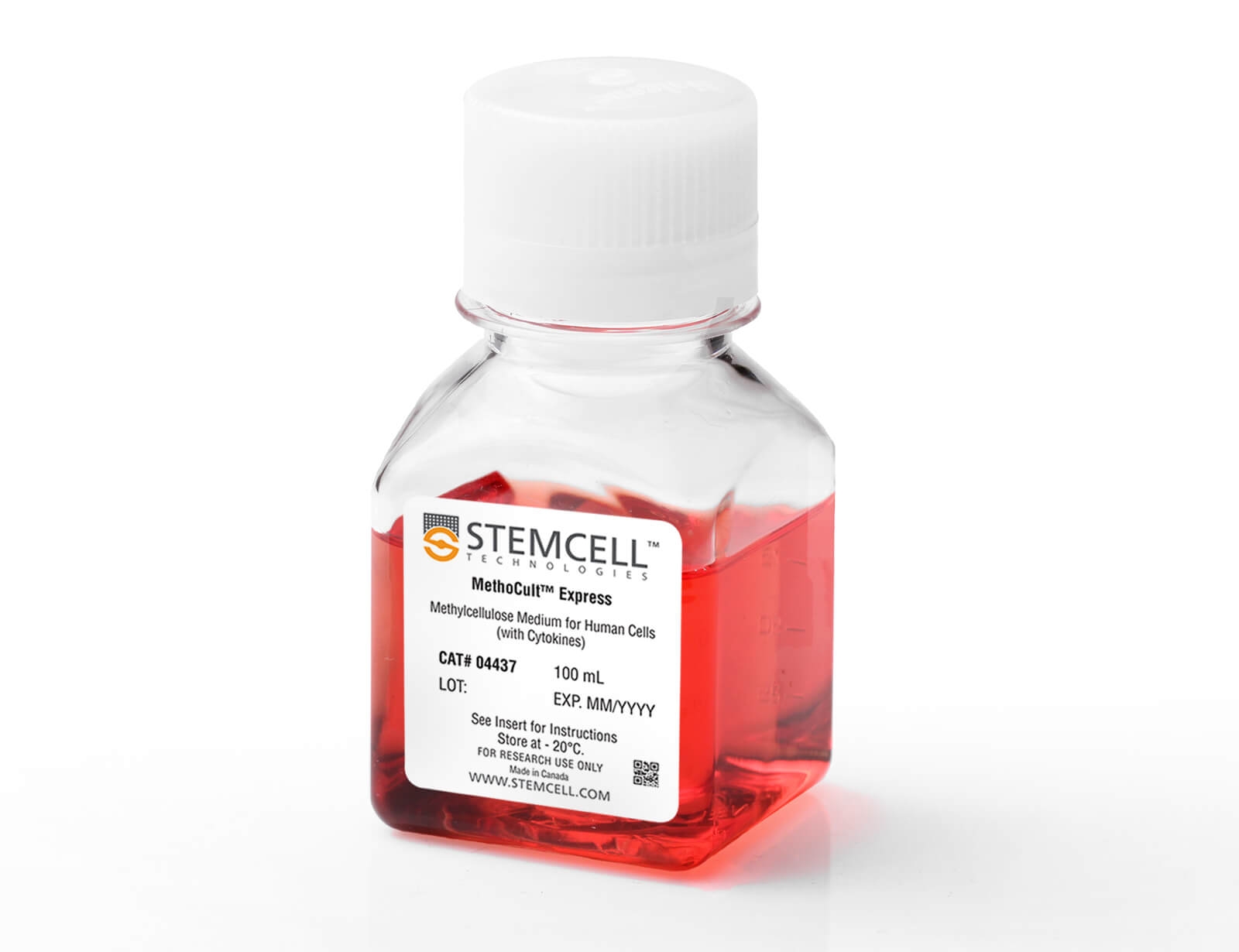MethoCult™ Express
Methylcellulose-based medium with recombinant cytokines for rapid hematopoietic colony assays of human cells
概要
MethoCult™ Express is intended for use in hematopoietic colony-forming unit (CFU) assays of human cord blood (CB) samples, after a minimum culture period of 7 days. It is recommended for use with red blood cell-depleted CB samples, whole CB samples that have been cryopreserved and thawed, and CB mononuclear cells. MethoCult™ Express is optimized for the growth and enumeration of human hematopoietic progenitor cells after much shorter periods than the 14 -16 days of standard CFU assays. In MethoCult™ Express, colonies containing at least 20 cells can be counted as early as after 7 days of culture. At this time, most colonies are immature and have not yet differentiated into morphologically distinguishable colony types. Therefore the colonies counted after 7 days of culture give information about the total frequency of hematopoietic progenitor cells present in the sample without distinction between different progenitor cell types. If MethoCult™ Express cultures are maintained for 14 - 16 days, colonies derived from erythroid progenitor cells (BFU-E), granulocyte-macrophage progenitor cells (CFU-GM, CFU-G, and CFU-M), and multi-potential granulocyte, erythroid, macrophage, and megakaryocyte progenitor cells (CFU-GEMM) can be counted.
Browse our Frequently Asked Questions (FAQs) on performing the CFU assay and explore its utility as part of the cell therapy workflow.
Browse our Frequently Asked Questions (FAQs) on performing the CFU assay and explore its utility as part of the cell therapy workflow.
Contains
• Methylcellulose in Iscove's MDM
• Fetal bovine serum
• Bovine serum albumin
• Cytokines, including erythropoietin (EPO)
• Supplements
• Fetal bovine serum
• Bovine serum albumin
• Cytokines, including erythropoietin (EPO)
• Supplements
Subtype
Semi-Solid Media, Specialized Media
Cell Type
Hematopoietic Stem and Progenitor Cells
Species
Human
Application
Cell Culture, Colony Assay, Functional Assay
Brand
MethoCult
Area of Interest
Cord Blood Banking, Stem Cell Biology, Transplantation Research
技术资料
| Document Type | 产品名称 | Catalog # | Lot # | 语言 |
|---|---|---|---|---|
| Product Information Sheet | MethoCult™ Express | 04437, 04447 | All | English |
| Manual | MethoCult™ Express | 04437 | All | English |
| Safety Data Sheet | MethoCult™ Express | 04437, 04447 | All | English |
数据及文献
Publications (9)
Blood 2011 MAR
NK314 potentiates antitumor activity with adult T-cell leukemia-lymphoma cells by inhibition of dual targets on topoisomerase IIalpha and DNA-dependent protein kinase.
Abstract
Abstract
Adult T-cell leukemia-lymphoma (ATL) is an aggressive disease, incurable by standard chemotherapy. NK314, a new anticancer agent possessing inhibitory activity specific for topoisomerase IIα (Top2α), inhibited the growth of various ATL cell lines (50% inhibitory concentration: 23-70nM) with more potent activity than that of etoposide. In addition to the induction of DNA double-strand breaks by inhibition of Top2α, NK314 induced degradation of the catalytic subunit of DNA-dependent protein kinase (DNA-PKcs), resulting in impaired DNA double-strand break repair. The contribution of DNA-PK to inhibition of cell growth was affirmed by the following results: NK314 inhibited cell growth of M059J (a DNA-PKcs-deficient cell line) and M059K (a cell line with DNA-PKcs present) with the same potency, whereas etoposide exhibited weak inhibition of cell growth with M059K cells. A DNA-PK specific inhibitor, NU7026, enhanced inhibitory activity of etoposide on M059K as well as on ATL cells. These results suggest that NK314 is a dual inhibitor of Top2α and DNA-PK. Because ATL cells express a high amount of DNA-PKcs, NK314 as a dual molecular targeting anticancer agent is a potential therapeutic tool for treatment of ATL.
Blood 2008 OCT
Unrelated donor umbilical cord blood transplantation for inherited metabolic disorders in 159 pediatric patients from a single center: influence of cellular composition of the graft on transplantation outcomes.
Abstract
Abstract
Outcomes of 159 young patients with inherited metabolic disorders (IMDs) undergoing transplantation with partially HLA-mismatched unrelated donor umbilical cord blood were studied to investigate the impact of graft and patient characteristics on engraftment, overall survival (OS), and graft-versus-host disease (GVHD). Patients received myeloablative chemotherapy (busulfan, cyclophosphamide, ATG) and cyclosporine-based GVHD prophylaxis. Infused cell doses were high (7.57 x 10(7)/kg) because of the patients' young age (median, 1.5 years) and small size (median, 12 kg). Median follow-up was 4.2 years (range, 1-11 years). The cumulative incidences of neutrophil and platelet engraftment were 87.1% (95% confidence interval [CI], 81.8%-92.4%) and 71.0% (95% CI, 63.7%-78.3%). A total of 97% achieved high (textgreater 90%) donor chimerism. Serum enzyme normalized in 97% of patients with diseases for which testings exist. Grade III/IV acute GVHD occurred in 10.3% (95% CI, 5.4%-15.2%) of patients. Extensive chronic GVHD occurred in 10.8% (95% CI, 5.7%-15.9%) of patients by 1 year. OS at 1 and 5 years was 71.8% (95% CI, 64.7%-78.9%) and 58.2% (95% CI, 49.7%-66.6%) in all patients and 84.5% (95% CI, 77.0%-92.0%) and 75.7% (95% CI, 66.1%-85.3%) in patients with high (80-100) performance score. In multivariate analysis, favorable factors for OS were high pretransplantation performance status, matched donor/recipient ethnicity, and higher infused colony forming units.
Bone marrow transplantation 2005 MAY
Association of post-thaw viable CD34+ cells and CFU-GM with time to hematopoietic engraftment.
Abstract
Abstract
In all, 78 peripheral hematopoietic progenitor cell collections from 52 patients were evaluated using our previously published validated post-thaw assays at the time of collection and following transplantation by assessment of viable CD34(+) cells, and granulocyte-macrophage colony-forming units (CFU-GM) cryopreserved in quality control vials. The median (range) post-thaw recovery of viable CD34(+) cells and CFU-GM was 66.4% (36.1-93.6%) and 63.0% (28.6-85.7%), respectively, which did not show significant correlation with the engraftment of either neutrophils (P=0.136 and 0.417, respectively) or platelets (P=0.88 and 0.126, respectively). However, the reinfused viable CD34(+) cells/kg of patient weight pre- or post-cryopreservation showed significant correlation to engraftment of neutrophils (P=0.0001 and 0.001, respectively) and platelets (P=0.023 and 0.010, respectively), whereas CFU-GM pre- or post-cryopreservation was significantly correlated to neutrophils (P=0.011 and 0.007, respectively) but not to platelets (P=0.112 and 0.100, respectively). The results show that post-cryopreservation assessment of viable CD34(+) cells or CFU-GM is as reliable a predictor of rapid engraftment as that of pre-cryopreservation measures. Therefore, the post-cryopreservation number of viable CD34(+) cells or CFU-GM should be used to eliminate the risks of unforeseen cell loss that could occur during cryopreservation or long-term storage.
Biology of blood and marrow transplantation : journal of the American Society for Blood and Marrow Transplantation 2005 APR
Predictive utility of the attached segment in the quality control of a cord blood graft.
Abstract
Abstract
The limited number of progenitor stem cells in umbilical cord blood (UCB) enforces the optimization and strict control of all the procedures involved in its therapeutic use--ie, collection, processing, cryopreservation, thawing, and transportation--to ensure graft potency at transplantation. For this reason, international UCB standards recommend storage of a cell sample attached to the UCB unit as a quantitative and functional control of the unit selected for transplantation. To validate the use of the sample attached to the UCB unit as a quality-control tool for the final product, UCB units (n = 20) stored in liquid nitrogen with the Bioarchive system were analyzed. The UCB units and their attached segments were thawed, and the number and viability of total nucleated cells, mononucleated cells, CD45 + cells, and CD34+ cells were determined, as were colony-forming cell counts. There was no significant difference between UCB units and segments for any of the parameters assessed. Additionally, the linear correlation coefficient (R2) in these paired samples was 0.85 and 0.78 for CD34+ cells and colony-forming cells, respectively. In conclusion, the cell sample in the tube segment physically linked to the transplant UCB bag predicts the total cell content and functionality of the unit and may serve as a source for final quality control of the UCB unit before transplantation.
Bone marrow transplantation 2004 JUN
Pre-transplant prognostic factors for patients with high-risk leukemia undergoing an unrelated cord blood transplantation.
Abstract
Abstract
From July 1995 to December 2001, 42 patients with leukemia aged 1-42 years underwent cord blood transplant (CBT) from unrelated, textless or = 2 antigen HLA mismatched donors. In all, 26 patients were in textless or = 2nd complete remission and 16 in more advanced phase. Conditioning regimens, graft-versus-host disease (GVHD) prophylaxis and supportive policy were uniform for all patients. The cumulative incidence of engraftment was 90% (95% CI: 0.78-0.91). The cumulative incidence of III-IV grade acute- and chronic-GVHD was 9% (95% CI: 0.04-0.24) and 35% (95% CI: 0.21-0.60), respectively. The 4-year cumulative incidence of transplant-related mortality (TRM) and relapse was 28% (95% CI: 0.17-0.47) and 25% (95% CI: 0.14-0.45), respectively. The 4-year overall survival (OS), leukemia-free survival (LFS) and event-free survival (EFS) were 45% (95% CI: 0.27-0.63), 47% (95% CI: 0.30-0.64) and 46% (95% CI: 0.30-0.62), respectively. In multivariate analysis, the most important factor affecting outcomes was the CFU-GM dose, associated with CMV serology (P=0.003 and 0.04, respectively) in influencing OS and with patient sex (P=0.008 and 0.03, respectively) in influencing LFS. Finally, CFU-GM dose was the only factor that affected EFS significantly (P=0.02). In conclusion, the infused cell dose expressed as in vitro progenitor cell growth is highly predictive of outcomes after an unrelated CBT and should be considered the main parameter in selecting cord blood units for transplant.
Blood 2000 OCT
Cell dose and speed of engraftment in placental/umbilical cord blood transplantation: graft progenitor cell content is a better predictor than nucleated cell quantity.
Abstract
Abstract
There is evidence that the total cellular content of placental cord blood (PCB) grafts is related to the speed of engraftment, though the total nucleated cell (TNC) dose is not a precise predictor of the time of neutrophil or platelet engraftment. It is important to understand the reasons for the quantitative association and to improve the criteria for selecting PCB grafts by using indices more precisely predictive of engraftment. The posttransplant course of 204 patients who received grafts evaluated for hematopoietic colony-forming cell (CFC) content among 562 patients reported previously were analyzed using univariate and multivariate life-table techniques to determine whether CFC doses predicted hematopoietic engraftment speed and risk for transplant-related events more accurately than the TNC dose. Actuarial times to neutrophil and platelet engraftment were shown to correlate with the cell dose, whether estimated as TNC or CFC per kilogram of recipient's weight. CFC association with the day of recovery of 500 neutrophils/microL, measured as the coefficient of correlation, was stronger than that of the TNC (R = -0.46 and -0.413, respectively). In multivariate tests of speed of platelet and neutrophil engraftment and of probability of posttransplantation events, the inclusion of CFC in the model displaced the significance of the high relative risks associated with TNC. The CFC content of PCB units is associated more rigorously with the major covariates of posttransplantation survival than is the TNC and is, therefore, a better index of the hematopoietic content of PCB grafts. (Blood. 2000;96:2717-2722)




